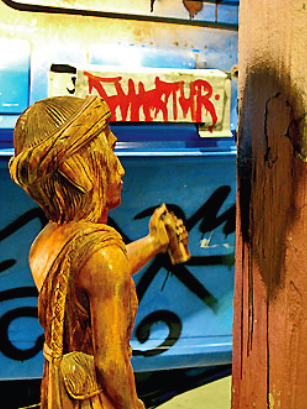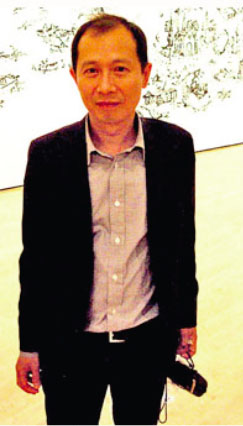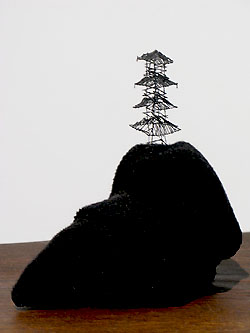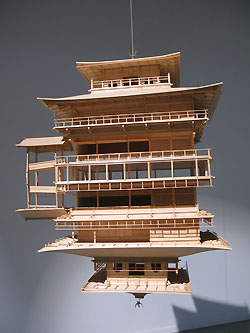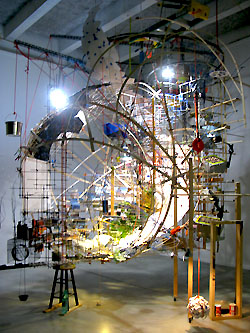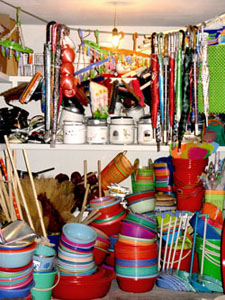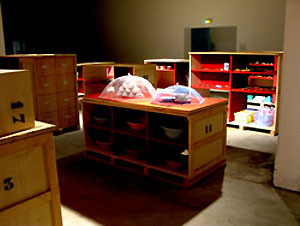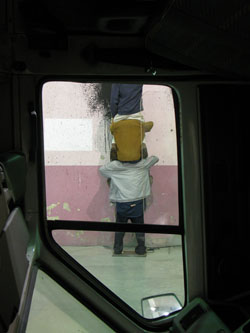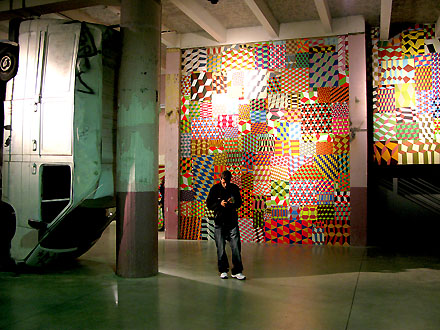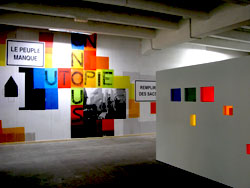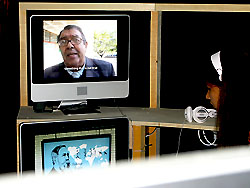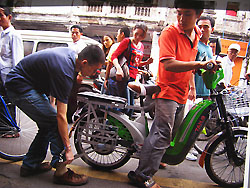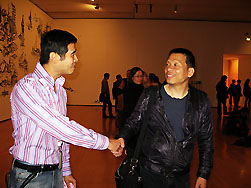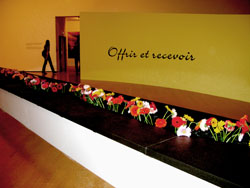|
|
| Reinventing the "Ordinary"
The
10th Biennale de Lyon, which runs until January 3, 2010,
takes a
particularly
intense look at the ordinary things that
we often overlook, and it establishes an unusual dialogue between
a promising group of international artists and the vast public
that is often ignored by the establishment. The official theme
is Le Spectacle du Quotidien, "The Spectacle
of the Everyday." Hou Hanru, the Biennale de Lyon's curator, brings us into the event not as a spectator but as a participant. The reinvention of the "ordinary" as a unique experience is intended to put ordinary people and artists on the same plane. Questions about the role of art in the 'quotidien'(or
everyday
life) lead to a reflection on social, political, cultural and
environmental
issues. The exhibitions are at La Sucrière (a former sugar
factory and warehouse at the Docks on the Rhône River),
The Museum of Contemporary Art, the Bichat Warehouse, and
the
Bullukian Foundation. 1) The
Magic of Things concentrates on artists who appropriate
and reinterpret the objects and experiences of our everyday
life and show us the potential for a new beauty. 2) Celebrating
the Drift deals with the urban environment and the new writing/reading
emerging especially in the streets. With globalization, many artists find new
spaces, more accessible, to develop strategies that give them more freedom but
also put them in a direct dialogue with the everybody evolving in the realm of
the everyday. The drift contains at the same time a geographical notion and a
political one. More artists are working in collaborative groups, combining different
disciplines and nationalities as well. The street is their place of choice to
give us the possibility of evolving and becoming a political animal. 3) Another
World is Possible is certainly one of the most surprising
approaches for a Biennale. "Art for art" is no longer an issue. There is a new
map of the world in which the "everywhere" is possible, and in
which artists and social activists increasingly look at alternatives to
create new
social models involving a reflection on democracy. 4) Living
Together, mainly installed in the Museum of Contemporary Art, focuses
on a dialogue with the city and the communities outside of it. Undeniably, there is a strong Asian presence at the Biennale. As Hou Hanru explains, art takes new dimensions in regions where social, economical and political tensions are particularly fervent. Artists from China, South East Asia, the Middle East and India have strong reasons for questioning their societies and values; and they do it on a large scale, and a visible one that puts them at the forefront when it comes to creativity. These artists are trying to understand their own deeply fractured heritage, largely ignored or ridiculed by colonial powers and by their own regimes that are often brutal. The globalization of financial markets and of communications forces these societies to reflect on their core values. The shift is quite significant. It provides a wealth of material with little in the way of an established structure to shape their expression -though this is changing now with the creation of important national museums and biennales in China, Japan, Korea, and Indonesia. The experiment focuses on a local scale with actors, who are rarely included in any decision-making process, much less one involving art. It is a testimony to the new imagination of artists confronted with the disastrous after effects of the current crisis.
The
notion of beauty will always be linked with art. But how do
you reinvent beauty and create a magical world when you are
surrounded
by so many
human and environmental disasters? Takahiro Iwasaki's sculptures
belong to the
meditative sphere that Westerners qualify as "Japanese." A "typical" oriental
landscape attracts our attention because of the beautiful contrast of the black
and the white. What a surprise to discover that the landscape is made of black
socks and bath towels! The tiny pagoda erected on this "everyday" material
looks ephemeral, nearly virtual. We nearly need a magnifying glass
to discover its existence on the edge of a cliff. It is a reminder
of our
own cultural
fragility.
"
Reflection
Model," done in 2001, is a double-axis representation
of a Tokyo palace suspended from the ceiling. The lake that
should reflect the image
of
the building is absent: our attention is caught in the mirage
of its reflection.
Reality extends to the enchanted part of the fantasy world
that we still imagine belongs to us.
Our
planet is at stake and Sarah Sze's Planetarium opens to allow
us inside to participate in its movements. This
fantastic
sculpture
makes
us dream
at first,
and then leads us to contemplate our own delusions, or
at least the items that keep us moving forward into a society
of consumerism.
Everything moves, animated
by a gentle force, nearly a romantic one. The sky is present
and an articulated
arm illuminates stars on a screen whose reflection appears
on the opposite wall as faded reflections of our own dreams.
When
looking
at the "Portable Planetarium," we
confront the notions of memory and accumulation. Familiar spaces do not usually get our attention. But when an entire shop is reconstituted in a cultural space, the experience of walking through it becomes a personal and social event. "What a Difference a Day Made," is a composite installation starting with a narrow passage through a tiny Chinese shop whose accumulated products were brought back en masse from Shanghai by the Taiwanese artist Michael Lin. Pots and pans, brooms and dust cloths, rice cookers and instant noodles, accumulated and superposed in layers from the ground to the ceiling, offer an exact image of a practical space where people can go anytime day and night to fulfill their household needs. As we walk through this tiny space, the viewer enters a bigger room where screens show a juggler. Sometimes, an object falls and we can hear the noise of a dish that broke. The noise is an allusion to the objects that we discover neatly presented in wooden crates displayed in an unspecified order. Woks, baskets, plastic buckets...everything from our modest existence is now gracefully arranged as though they were on museum shelves. Objects from our everyday use are catalogued and placed according to function, color, and shape. The "everyday" becomes "spectacle" by connecting us with personal and collective memory, objects and situations.
The city offers artists new opportunities to dialogue with communities. The flow of ideas, frustrations, constraints, collides with environments that were originally conceived to protect social values. New forms allow us to go beyond spatial constraints and political power. When graffiti emerged from the guts of New York City in the late 1960s and covered deteriorated walls and ramshackle subway cars, a youth expressed -consciously or not- its anger against an establishment that had failed and abandoned them essentially because they were Hispanic and African- American. The movement created new forms of writing. Today, Sao Paulo, a city rapidly expanding to accommodate its population, which is soon expected to reach 25 million, is running short in innovative architectural and urban planning models. The pixaçao was born in the 1960s to confront dictatorship. The pixadores, who often can barely write, represent an assault by the favelas against the cultural and financial ghettoization of the city. These signs of courage and desperation are usually made at night. Each morning, they appear as signs of an infringement against the establishment, although they are really an attempt to communicate with the population.
UN
NOUS, a group working as a collaborative, created in France
in 2006, proposes an exchange with the city. Its members, Antonio
Gallego, Jose Maria Gonzalez, Patrick Pinon and Roberto Martinez
question the notions of meeting and connectedness between the
city's fabric and its people. For the Biennale, they have combined
an exhibition space with an "audible
and luminous utopia,"composed of a big rectangular volume
pierced with Plexiglas windows placed at different levels
forcing the spectator to either stand on tip-toe or bend
over to be at eye-level in order to look at a fantastic city
inside, a white city composed of everyday objects. Egg boxes,
juice containers, old toys, miniature animals, are jumbled
next to fragments of models created by architecture students
from schools in Versailles, Grenoble, Saint-Etienne and Lyon.
These models were destined to be demolished.
With
his "Graffiti Cut," Carlos Motta, the Columbian
artist born in 1978 in Bogota, positions small graffiti
next to each other
on a wall-like
structure
painted black and located in a darkened room. The words
and short sentences that we discover here are real slogans
that
the artist
copied from
walls in various
cities. Placed out of context, they act as banners through
which light emerges. The slogans glow lightly in the dark
of our unconsciousness.
They require
our attention to be deciphered. By documenting the feelings
that affect
people the most -God, oppression, torture, money, capitalism-in
the misery of their
daily
life, Carlos Motta creates an archival monument to the
Unknown of the Street.
In
another project but this time at the Museum of Contemporary
Art, the same artist, invites us to sit and take our
time to watch over
400 interviews
made with passers-by in the streets of twelve Latin-
American cities. "The
Good Life (2005)," records people's sentiment over
American interventionism and their own government. It
is a cry for democracy
as perceived by ordinary people.
In parallel, Oliver Ressler asked the question "What
is Democracy?" to
people from cities around the world, including Amsterdam,
Sydney, New York, Tel Aviv. Their answers are shown on
eight video
screens, composing
a mosaic
of opinions
and attitudes questioning existing democracies and their
survival. The two projects, Motta's and Ressler's, are
placed in the
same room divided
only
by a small partition
that helps us to go back and forth between the two models.
On the one hand you have powerful parliamentary democracies,
which
can
substitute themselves for individual initiative, and
on the other you have emergent voices of people trying
to
create an indigenous system. The dialogue is not an easy
one, but
without it our daily life can be reduced
once again by exploitation of the spectacle. In
that spirit, two artistic experiments are related in their
approach to the "other." Lin
Yilin, a Chinese artist from Mainland China, spends his time between
Guangzhou and New York. At La Sucrière, he presents 37 photographs
and two videos
focused on an event that marked the artist "One Day" in
2006 in the streets of Guangzhou. Lin Yilin saw two
young men walking on
a crowded street.
One was a plainclothes policeman and the other a petty
thief, who was bent over nearly double because his
wrist was handcuffed
to
his ankle.
Lin Yilin
was struck
by the indignity of the situation, and by the fact
that people looked at the scene without intervening.
Shocked
by what
he saw as a lack
of compassion,
Lin Yilin, hired an actor to reenact the scene in public
in China, and had
the scene
videotaped. No one seemed to bother or ask what was
going on. The lack of a
connection is striking in the busy life of cities and
reveals what appears to be a lack
of humanity. Lin Yilin reenacted the same event himself
at the Tomb of the Unknown Soldier at Paris' Arc de
Triomphe, and the
results
were the
same
except that
eventually two French police officers asked the artist
to
stage his happening at a different location. In both
countries, the
conclusion was the same,
that there are certain scenes that we choose not to
question in our
everyday life,
not even in Western democracies. If we were to do so,
we would cross the boundaries from being a spectator
to becoming
an
actor in our
own tragedy.
In
contrast, Lee Mingwei puts us in a situation where a simple
gesture enables
us to communicate with
others.
The
Taiwanese artist, who lives in New York, works with
the symbolism of our daily life. "The Moving Garden," exhibited
at the Musée d'Art Contemporain, is an installation
composed of a long, narrow, granite table on which
fresh flowers
are placed every day. The visitor is invited to pick-up
a flower with two conditions: he or she must give the
flower to a complete
stranger and this must be done outside
the exhibition. These conditions seem easy enough
because they involve doing something that is nice and
related to pleasure. But
at the exhibition, some people
instinctively gave the flower to a friend or a spouse
rather than looking for a stranger. Others did follow
Lee Mingwei's instructions,
and offered the flower
to a passer-by in the street. I gave mine, which
I received from a young man waiting for the bus, to
the lady at the cloakroom of
La Sucrière
the night of the opening. In Lee Mingwei's installation,
the act of giving and
receiving
involves bringing people together, and to do that
we must connect with our "I" in
order to relate to the "
we." It is an act, which epitomizes the Biennale, when
alternative visions of the world come from the gestures
of ordinary people,
who perceive themselves in their human and cultural
universalism. This
article was first published in the internet magazine The
Essential Edge. Michèle
Vicat is one of the arts editors for The Essential Edge. |
All material copyright 2010 by 3 dots water

